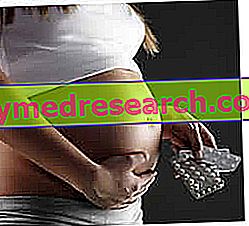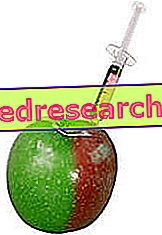Generality
Under the term "gravidic jaundice" are included all those gestational situations characterized by an abnormal increase in blood bilirubin, so that the skin and ocular sclerae take on a typically yellowish color.
Causes
The numerous causes capable of provoking gravidar jaundice must first be distinguished into:
- hepatopathies in pregnancy: causes already present at the time of conception, which occur during gestation due to external factors independent of it;
- hepatopathies of pregnancy: caused or aggravated by the same gestation.
Intrahepatic cholestasis
Among the liver diseases caused by gestation, the most common cause of jaundice is intrahepatic cholestasis of pregnancy .

Incidence
Intrahepatic gravidic cholestasis complicates from 0.8% to 1.5% of pregnancies, manifesting itself clinically in the second half of gestation; the characteristic symptom is the intense itching, associated with jaundice in about 20% of cases. More common in some populations (Chile and Scandinavia), intrahepatic cholestasis of pregnancy has a benign course (may slightly increase the risk of biliary lithiasis) and disappears after delivery; however, it tends to recur in subsequent pregnancies or with oral contraceptives. Furthermore, it exposes the fetus to an increased risk of premature birth and developmental abnormalities.
The treatment of intrahepatic cholestasis of pregnancy is based on the use of ion exchange resins, such as cholestyramine, which inhibit the intestinal reabsorption of bile salts.
Pre-eclampsia
Pre-eclampsia is another hepatopathy of pregnancy potentially responsible for jaundice.
It occurs during the second half of gestation, being characterized by a significant increase in blood pressure and water retention (the appearance of edema and swelling), renal damage with possible proteinuria and foamy urine, and the presence of anemia with reduced platelets circulating. Pre-eclampsia, a very dangerous condition for both mother and fetus, is also characterized by a hyperbilirubinemia sometimes accompanied by jaundice.
The pivotal symptoms are represented by headache, visual disturbances (for example scotomas) and abdominal discomforts, while in the most rare and serious cases authentic epileptic attacks occur followed by loss of consciousness. The treatment of pre-eclampsia involves the use of hypotensive and anticonvulsant drugs, until the artificial induction of childbirth as soon as the fetus is considered sufficiently mature.
Acute hepatic steatosis of pregnancy
Acute hepatic steatosis of pregnancy is another very serious complication, fortunately rare (1 case per 13, 000 pregnancies). Often associated with pre-eclampsia and more common in twin pregnancies, it appears in the last months of pregnancy with a symptomatology characterized by nausea and vomiting, abdominal pain, general malaise with flu-like symptoms and loss of appetite. Jaundice appears on average one to two weeks after the onset of symptoms and may lead to liver failure; also in this case the most effective therapeutic intervention consists in the rapid completion of the birth.
Other Causes of Jaundice in Pregnancy
Among the liver diseases not directly caused by the pregnancy we remember the viral hepatitis, quite frequent in developing countries, but fortunately rare in Italy and in industrialized countries.
See in this regard the articles related to: hepatitis A, hepatitis B, hepatitis C, hepatitis D and hepatitis E. Other causes are represented by autoimmune hepatitis, chronic liver diseases such as liver cirrhosis and emoledic diseases (it is relatively common the HEELP syndrome, a form of anemia characterized by haemolysis, platelet decline and increase in liver function indexes, often associated with pre-eclampsia).
Liver disease typically aggravated by pregnancy is gall bladder jaundice due to the formation of small pebbles (calculi) inside the biliary tract. In addition to an innate predisposition, this phenomenon seems favored by the hormonal changes associated with pregnancy. For example, the increase in progesterone reduces the motility of the gallbladder and in general of the entire gastrointestinal system, while the increase in estrogen is associated with hypercholesterolemia. The most common therapeutic intervention is the laparoscopic removal of the gallbladder.
Symptoms
Whatever the cause, skin jaundice is more evident in patients with fair and anemic complexions. Instead it is less evident in patients with dark or edematous skin, for whom it needs higher levels of bilirubinemia in order to be clinically evident.
Since this is a relatively late symptom of liver disease, it is advisable to report to the doctor any symptom that makes you suspect the presence of a liver disease (loss of appetite; fatigue, discomfort and significant weight loss; dark coloration of the urine or clear stool; nausea, vomiting, diarrhea, hypoglycemia, low-grade fever and muscle pain). The appearance of abdominal pains or contractions, localized in the hepatic site (upper right abdominal region) or diffused in other abdominal sites, is worthy of an immediate medical consultation.
Finally, regardless of the presence or absence of jaundice and liver disease, we recall the importance of a diet low in fried foods, animal fats, coffee, tea and of course alcohol (absolutely forbidden in pregnancy), useful for lightening the work of the liver during whole period of pregnancy.



